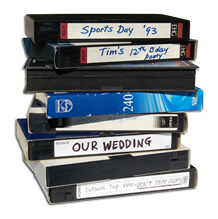 Chunky, heavy and often un-relliable as they aged, VHS tapes are firmly consigned to the history books...
Chunky, heavy and often un-relliable as they aged, VHS tapes are firmly consigned to the history books...As HD televisions become the norm, the majority of previous video formats to the Blu-ray format have all become nearly obsolete. However, as many people have built-up a collection on VHS and DVD, replacing them on Blu-ray can be an extortionate task in itself, purely due to both cost and finding the rarity titles.
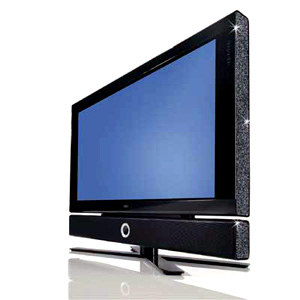 HD Televisions, such as this Loewe Individual, are becoming the dominant television experience...
HD Televisions, such as this Loewe Individual, are becoming the dominant television experience...
The modern-world allows for the likes of Blu-ray and streaming services to take the lead when watching films. However, most people record their own recordings onto a hard-drive recording system, assigning VHS and even DVDs to the history books. However, with a lot of people realising the cost of replacing their films on a more modern format, as well as people realising that their memories of family events are on these aging formats, the consumer is still using their previous formats in with their modern HD systems.
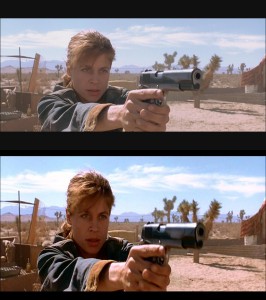 A visual comparison of DVD and Blu-ray qualities. DVD at the top, Blu-ray at the bottom...
A visual comparison of DVD and Blu-ray qualities. DVD at the top, Blu-ray at the bottom...This guide is going to look at how to incorporate these aging formats into your current set-up, enabling you to enjoy your priceless memories for a lot longer; with greater quality than before, too.
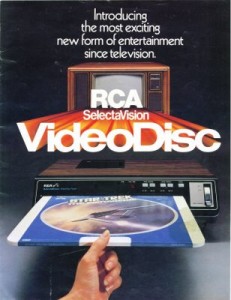 With obsolete formats offering rare titles, some people still choose to re-commission their original equipment...
With obsolete formats offering rare titles, some people still choose to re-commission their original equipment...To start with we must remember that a modern television system will primarily consist of digital components. For example, a new television will consist of digital technology inside, just like a DVD or a Blu-ray player would, too. A VHS system is analogue, and, therefore, consists of technology from yester-year. It doesn’t mean that both new and old equipment will be incompatible, but it means things will run slightly differently to an exclusively all-digital system. Primarily, a digital television will process an analogue feed differently: the digital system will process that signal in time, at that time; an analogue format is originally a constant processed picture. As it’s originally a constant feed, digital will break the picture into individual segments, thus causing an occasional jitter of movement on the screen. To help to resolve this, a good quality Scart lead, such as QED’s Profile Scart, will help to reduce this problem by giving a faster signal transport from the video to the receiving equipment.
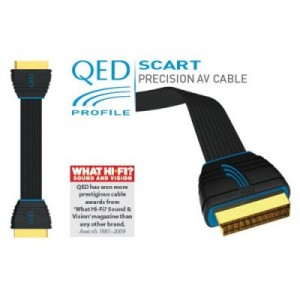 The traditional scart lead offers greater quality than the original coaxial or single video cables...
The traditional scart lead offers greater quality than the original coaxial or single video cables...Now a good connection has been established, and to improve signal clarity further, ensuring the VHS’ heads are cleaned and in good condition will help to refine the picture; ensuring the picture is sharp will help with any time jitter or lagging as it’s a purer picture to process for the end result on the television screen. Also, look at adjusting the head’s tracking when watching the video to get an even more defined picture.
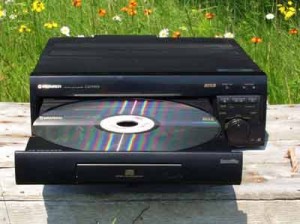 Laserdisc was the start of the digital video revolution - albeit a little flawed on price and convenience...
Laserdisc was the start of the digital video revolution - albeit a little flawed on price and convenience...If you wish to re-commission an older digital video system, such as a lazer-disc player, it’s a similar principle than that of VHS. Using a good quality lead will help to transfer the signals of the player to the receiving equipment with better results overall. However, ensure that your discs are clean, too. Fingerprints and grease can stop the disc from being read at a more efficient rate. Try using Milty’s range of disc cleaners which is suitable for all digital discs, including DVD, Blu-ray, CD, Super Audio CD and Lazerdisc.
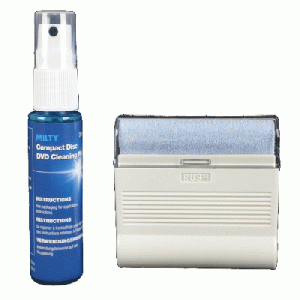 Milty's Disc Cleaning solutions...
Milty's Disc Cleaning solutions...If you are re-commissioning older video equipment, be sure to follow the above, and you’ll enjoy your previous video collections at a higher rate of quality that your probably ever did before.